The Final Trio of Swedish Lloyd Line Passenger Ferries
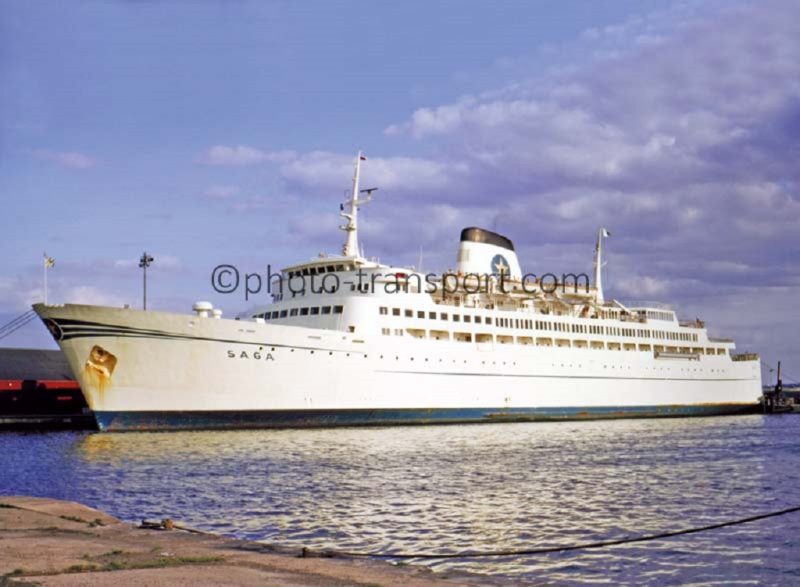
This trio of ferries were all built by the Lindholmen yard in Gothenburg harbour during 1966 and 1967, and all have had very long careers of between 37 and 54 years of service. Patricia was a favourite ship and was seen by many people in different parts of the world, and only during 2021 was she sent to the breakers yard at Alang in India. The Lindholmen yard was also in service for the very long period between 1848 and 1976, and was named after the small leaf of the Linden tree that grew on the island of Gota Alv in Gothenburg harbour. The first iron hulled sailing ship built there was Gustaf II Adolf when she was launched on 13th December 1854. After the yard was dismantled, it became a training centre for unemployed shipyard workers of all the former yards in Gothenburg in the early 1990s, and then became the present Lindholmen Science Park in the late 1990s.
HISTORY OF SWEDISH LLOYD LINE
The company was founded on 23rd January 1869 for coastal tramping around the Baltic and North Seas. The first ship owned by the company was the flush decked Sweden of 500 dwt and 140 feet in length and delivered in 1869 by the Keiller yard in Gothenburg harbour, later to become the famous Gotaverken yard. Engineers F. Hansson and J. Norin and ship master J. F. Olsson had designed the vessel with a compound steam engine aft of 45 horse power giving a service speed of seven knots, and four masts for cargo handling. Adolph Meyer was elected Chairman of the company, and the Royal Swedish Academy of Sciences drew up the Articles of Association of the new company, which had a share capital of 100,000 riksdaler. However, the new ship sank off the coast of Norway on Boxing Day of 1869, but was replaced by Sweden (2) of 600 dwt from the Lindholmen yard in 1871.
At the end of 1872, the company owned four steamers named Sweden, Norway, Denmark and Scandinavia, all of 600 dwt, with the company capital then increased to 575,000 riksdaler. In 1873, a first regular service was begun between Christiania (later Oslo) and Newcastle, but the trade was insufficient and the service was discontinued in the Autumn of the same year.
The company was quickly after only a year of trading also able to take a large part of the Swedish transhipment trade at Hamburg by acquiring an existing shipping line. Two steamers ran on the Hamburg line in 1874 and the service was extended to Bordeaux. Also in the same year of 1874, a trade to the Mediterranean was established, run by the fast steamer Helios of 725 dwt and completed on the Tyne in 1857. The company had a fleet of ten steamers in 1890, and the Mediterranean trade had by 1913 established a monopoly of trade between Swedish and Baltic ports and Mediterranean ports. Adolph Meyer had been the driving force of the company until 1893, when W. Frodi took over the leadership for the next twenty years until Herbert Metcalfe took over the management in 1912. He then established tariff agreements with the foreign shipping companies operating routes between the Mediterranean and Northern Europe. In 1913, trade began to Dunkirk, which six years later was extended to Calais and Dieppe, and Mediterranean shipping was restructured to offer services between Sweden and Southern France, Portugal, Spain, Italy and North Africa. Two new steamers, Anglia of 3,230 dwt and Liguria of 3,315 dwt, were completed by the Lindholmen yard in 1914. Anglia was unfortunately lost in the same year by collision in the River Parana after loading a cargo of grain homeward to Sweden.
The size of the fleet grew quickly to over thirty cargo ships for general cargo and the fruit trades from Sicily and the Levant, but it was only the takeover of three very old lines of Angfartygs A/B Thule Line of Sweden, Angfartygs A/B Gothenburg-Manchester, and Angfartygs A/B Svithoid in 1915/16 that passenger shipping became very important with the east and west coasts of Britain. (‘Angfartys’ means steamers). Nineteen steamers came from these three lines including the passenger ships Balder, Bele, Ingeborg, Thorsten, Thule and Saga (1) taken over from Thule Line in January 1916 on the Gothenburg to the Thames service. The latter ship was of 2,809 grt and had been built at Wallsend by Swan, Hunter & Wigham Richardson Ltd. for Thule Line, she was sold in 1929 to the big fleet of the Compagnie Generale Transatlantique (French Line) and renamed Mayenne, but was seized by Italy in 1942 and renamed Fabriano and was sunk by aerial torpedo on 11th May 1943.
The size of the company fleet at the end of 1916 was 42 steamers of 84,028 grt, however the steamers Victoria, Germania and Bothnia became war losses. The insurance compensation money allowed six more steamers to be purchased, with five more steamers gained through the acquisition of Nordiska Rederi A/B, and six new steamers were ordered from Swedish yards. The engines ‘midships quarter decker Portos of 1,798 grt was built by Wood, Skinner & Co. Ltd., Gateshead as Dordrecht for Phillips van Ommeren of Holland, and was taken over in the fleet of Nordiska Rederi A/B in 1916, remaining in the Swedish Lloyd Line fleet until sold in 1925.
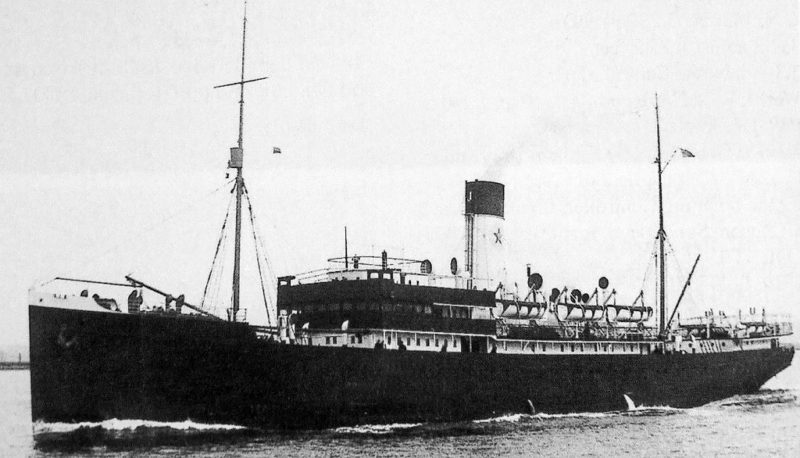
A new Newcastle to Gothenburg service was inaugurated in April 1919 with Saga (1) and a passenger ship of 2,981 grt that had been built back in 1901 for the Vladivostock to Shanghai service of the Chinese Eastern Railway Company as Mongolia, moving to the fleet of the West Australian Government as Western Australia in 1910. She was extensively refurbished by the Lindholmen yard for the Newcastle service, but was renamed Patricia (1) in 1919 and transferred to the London service, along with Saga (1). The Newcastle to Gothenburg service was weekly on Tuesdays in each direction in 1924 using Balder of 1,486 grt and Thule of 1,914 grt. However, the 1920s were initially characterised by declining economic conditions and profitability, with Patricia (1) sold to the United Baltic Corporation (UBC) in May 1929 and renamed Baltrover.
A big share of the available passenger and cargo trades between Sweden and England was taken in 1929 with the completion of the elegant passenger sisters Britannia and Suecia by Swan, Hunter & Wigham Richardson Ltd. They had a Promenade ‘A’ deck for most of the First Class public rooms, a ‘B’ Deck for the First Class Dining Room as well as cabins for Cabin de Luxe and Second Class, and a ‘C’ Deck for the First Class cabins and a few Second Class aft, giving accommodation for 265 passengers (220 in First, 45 in Second). They had a refrigerated and general cargo capacity of 2,210 tonnes. The hulls had two steel decks including the weather deck, with a third steel deck in numbers 2, 3 and 4 holds, and they were strengthened for navigation in ice. The pair were of 4,216 grt and had dimensions of overall length of 376.3 feet, moulded beam of 50.3 feet, and a moulded depth of 29.1 feet, and a loaded draft of 20.3 feet, and were powered by three Parsons steam turbines, double reduction geared to a single shaft to give 5700 shp and a service speed of 17.5 knots.
They had seven bulkheads, with the collision bulkhead to the weather deck, and a total of 592 tons of water ballast in the double bottom, and in way of the shaft tunnels, and in the forepeak and aft peak. They were originally coal burners, but were converted to oil burning later in their long Swedish Lloyd Line careers.
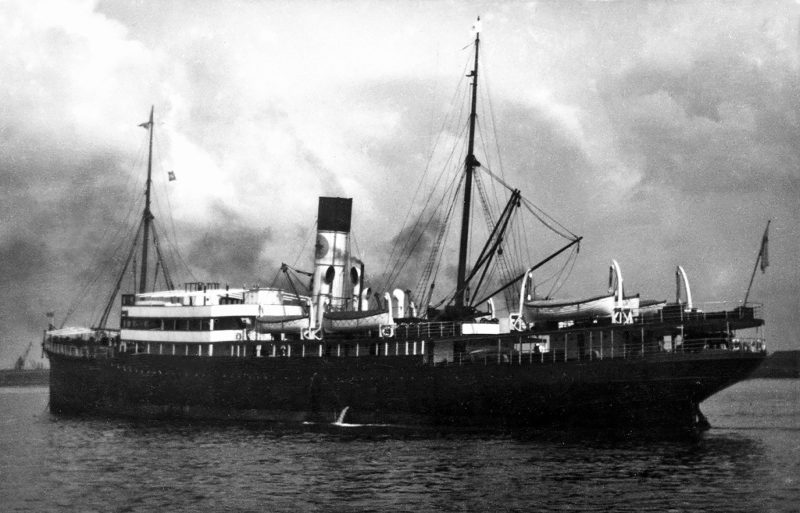
Suecia (Yard number 1363) was launched first on 24th January 1929, followed by Britannia (Yard number 1300) on 27th February 1929, with both completed and making their maiden voyages in June of that year. They had black hulls with red boot topping, white ventilators, blue insides of cowls and cream masts and derricks, with white funnels and a black top and a blue circle with a yellow star on the white part. The cargo ships of the fleet usually had grey hulls, with black funnels with a central white band bearing the same logo. The first Swedish Lloyd Line funnel in 1869 had been black with a yellow band bearing a red ‘L’, changed to the more familiar funnel colours in 1916. The houseflag was always white with a blue Maltese cross.
Britannia and Suecia offered Wednesday and Saturday sailings from Tilbury to Gothenburg to give a long holiday of seven days duration, sailing from Tilbury in the early evening and arriving at Gothenburg at noon on the third day. The liners were used for sleeping each night for the three days of sightseeing and exploring the city of Gothenburg, sailing in the early evening of the fifth day and arriving at Tilbury at noon on the seventh day. No passports were required by British subjects, although an extended stay in Sweden of up to three months was available for travellers with passports. The cost of a Second Class return ticket in 1936 was only £6.50 or in today’s money of around £120.
A better and longer holiday of nine days duration was also available to give the traveller some time in Gothenburg, Stockholm and Saltsjobaden near the Stockholm archipelago. A First Class cabin from Tilbury to Gothenburg was followed by a First Class rail ticket to Stockholm to view the many lakes in Sweden before staying at a First Class hotel in Stockholm.
A full day of exploring Stockholm lay in store for the fourth day, followed by on the fifth day a visit to Saltsjobaden by steamer and electric railway. On the sixth day, travellers left Stockholm by the night train to Gothenburg, arriving in the early morning for a final day of exploring this great port city. A First Class cabin for the voyage home that began in the evening of the seventh day, arrived at Tilbury at noon on the ninth day. The cost of a First Class return ticket and a holiday of nine days in 1936 was only £19.50 or in today’s money of around £400.
The Newcastle to Gothenburg passenger and cargo service was operated in 1927 by Balder and the newly purchased Cambria of 756 grt until 1930, when Balder was renamed Northumbria to better indicate her area of service. The latter ship was partnered by Ingeborg of 1,156 grt, one of the several ships taken over from Thule Line in 1916, for a few years until Northumbria sailed alone and was confiscated by Germany in 1940. She was used under the name of Eupen for three years until she was attacked by planes off Gdynia and sunk. The Newcastle passenger service did not operate in post-war years, with only a cargo ship service.
The fleet strength in 1934 was 32 steamers plus three new motorships delivered that year by the Kockums yard at Malmo as Scania, Sicilia and Gdynia of 2,650 dwt for the Mediterranean trades. A steam powered tug was also owned for towage duties in Gothenburg harbour. The Tilbury to Gothenburg passenger service was increased to three ships in 1935 when Patris II of 3,902 grt was purchased from National Greek Line and renamed Patricia (2) to run alongside Britannia and Suecia. She had been built in 1926 by Swan, Hunter & Wigham Richardson Ltd. for the Byron Steamship Company operated by the Embiricos Brothers.
The company was able to restart the payment of dividends to shareholders in 1936 for the first time in fifteen years, the long years of the Great Depression of 1929 had created many difficulties.
On 4th March 1937, during the launch of the motorship Kollbjorg at the Gotaverken yard where Suecia was being converted to oil burning, Suecia was hit by the new ship and sank at her berth, but was back in service in June 1937 after being raised and repaired. Britannia was also converted to oil burning at that time at the same yard, but she and sister Suecia were laid up in Gothenburg harbour for the duration of World War II after the closure of the London service. The sisters were reactivated in March 1945 to carry British soldiers between London and Antwerp and Hull to Cuxhaven on charter to the British Government, and resumed their London to Gothenburg service in the summer of 1946.
Patricia (2) in 1941 became a submarine depot ship for the Swedish Navy, and she continued in this role in post-war years until she arrived at Santander in 1973 for breaking up under the name of Gele. The big cargo ship fleet of thirty steam and diesel powered ships in 1939 suffered a severe loss of twenty ships during World War II to both German and British attacking planes and submarines, and unfortunately the lives of 104 brave crew members. Some ships came under Allied control for convoy service worldwide, while others were requisitioned by Germany for Baltic operations.

POST-WORLD WAR II TRADING
The big Swedish Lloyd Line cargo ship fleet was rebuilt in post-war years to three dozen engines ‘midships or ‘three quarters aft’ vessels by 1959, with ten ships of 2,900 dwt named Adria, Algeria, Camelia, Campania, Dahlia, Industria, Scania, Tunisia, Vicia and Virginia, eight ships of 3,500 dwt named Almeria, Gandia, Iberia, Massilia, Murcia, Sicilia, Valencia and Venezia, and others in step sizes up to 6,300 dwt of Begonia with bipod masts and a 15 knot service speed from a seven cylinder GV diesel engine when built in 1958 by the Lindholmen yard. Scandinavia of 3,241 grt and 6,432 dwt was completed in 1945 by the Gotaverken yard for Swedish Lloyd Line and served for 25 years on North European and Mediterranean services until sold in 1970 to Greek owners. These services of this big fleet were as follows:-
Gothenburg, Halmstad and Uddevalla to London, Tyne, Leith, Grangemouth, and Methil
Malmo, Helsingborg and Halmstad to Liverpool and Manchester
Gothenburg to Dunkirk, Calais, La Pallice and Bordeaux
West Swedish ports to Hamburg and Emden Swedish ports to St. Malo, Nantes, Portugal, Spain, Southern France, Italy, Jugoslavia, Algeria, Morocco and Tangiers
Gdansk and Gydnia to Spain, Southern France, Italy, Jugoslavia and Algeria
Finnish ports to Spain, Southern France, Italy, Jugoslavia and Algeria
The Mediterranean routes were the most economically profitable and were expanded with newbuilds, purchased ships and chartered ships. Pallet systems using sideports that worked well in North European ports were inappropriate for Mediterranean ports. Instead, terylene rope slings were specially designed to lift cargo from quay to hold of ship without mechanised handling. Traffic to British ports was less profitable, and small ‘paragraph’ coasters were tried instead of larger ships, the first pair were Fragaria and Stellaria of 367 grt and 540 dwt in 1952 but proved to be too small. Larger ‘paragraph’ coasters of 499 grt and 900 dwt were then built from 1955 named Celia, Cordelia, Hermia, Ophelia, Octavia, Portia, Silvia and Valeria. I well remember Celia arriving and sailing from the Tyne on her weekly triangular trade between Gothenburg, Leith and Newcastle Quay between 1955 and 1966. These bigger ‘paragraph’ coasters loaded 25 tons per hour against the 10 tons per hour of the two smallest ‘paragraph’ coasters.
Two new passenger ships were built for the Tilbury to Gothenburg service between 1946 and 1951 to run alongside Britannia and Suecia. These were Saga (2) of 6,458 grt from the Landskrona yard of Gotaverken Oresundsvarvet A/B in May 1946, with accommodation for 340 passengers (160 First Class, 80 Second Class, and 100 in Third Class), and Patricia (3) of 7,764 grt in 1951 from the Wallsend yard of Swan, Hunter & Wigham Richardson Ltd. with accommodation for 550 passengers (12 First Class in De-luxe suites on ‘A’ deck, 154 First Class in single and two berth cabins on ‘B’ and ‘C’ decks with those on ‘B’ deck having adjoining private toilets, 78 Second Class in two and three berth cabins on ‘C’ deck, and 100 Third Class in two and four berth cabins on ‘D’ deck, plus dormitory style accommodation in cabins for up to a dozen occupants.
Saga (2) had an overall length of 420 feet, and had been designed for winter cruising, making voyages in her first year of service to the North Cape of Norway and to the Canary Islands, her service speed of 18.5 knots came from four Gotaverken diesel engines geared to a single screw.
Patricia (3) had been launched on the Tyne on 8th November 1950 and completed six months later with dimensions of overall length 441.9 feet, moulded beam of 58.3 feet, and moulded depth of 28.3 feet, and her service speed of 19.0 knots came from three steam turbines single reduction geared to a single screw. She carried 2,300 tons of general and refrigerated cargo on a loaded draft of 19.0 feet. She carried eight lifeboats, with A/B Nordiska Kompaniet of Stockholm commissioned for the decoration of the First Class Lounge, Dining Room, bar, library and entrance hall, while the decoration of the First Class Smoking Room was by Maple & Co. Ltd. of London. Patricia (3) was also designed for cruising and sailed from Tilbury in December 1955 for six months of Caribbean cruising. The positioning voyage called at Ponta Delgada in the Azores, Bridgetown on Barbados, Port of Spain, La Guaira, Willemstad, Kingston and Nassau before arriving at her base of New York.
A new terminal called the London Pier was completed in 1951 in Gothenburg harbour. However, the four passenger ships on the Tilbury to Gothenburg service proved to have far too much accommodation even in the busy summer season. Competition with the airlines had begun, with Saga (2) sold in 1956 to French Line, and Patricia (3) sold in 1957 to Hamburg Amerika Line to become their full time cruise ship Ariadne. The 1929 built pair of Britannia and Suecia then sailed on alone until sold in 1966 after 37 years of service. Their new owners were Hellenic Mediterranean Lines (HML) of Greece and they were renamed Isthmia (ex Suecia) and Cynthia (ex Britannia), with Isthmia broken up at Kartal in October 1973, and Cynthia at Savona in January 1973.
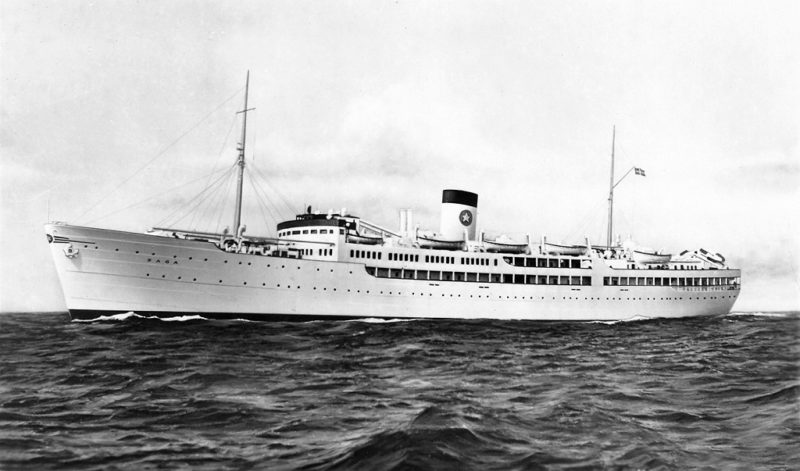
ENGLAND-SWEDEN LINE (ELS)
Passengers in England could from 1966 take their cars to Gothenburg on holiday to tour the magnificent lake and mountain scenery of Sweden. The ‘car ship’ era had begun with other ferry operators in the early 1960s, and with the ELS consortium service it comprised one ro-ro passenger ship each from Swedish Lloyd Line, Rederi A/B Svea of Stockholm, and Ellerman Wilson Line of Hull. The Lindholmen yard in Gothenburg harbour built Saga (3) for Swedish Lloyd Line as Yard number 1094, and Svea for Rederi A/B Svea of Stockholm as Yard number 1093, which became Hispania in the Swedish Lloyd Line fleet in 1968, while Spero for Ellerman Wilson Line from the Cammell, Laird yard at Birkenhead as Yard number 1322. Svea was of 8,554 grt and 1,950 dwt and carried 408 passengers and 100 cars and 100 containers or trailers at a service speed of 18.5 knots from four 6-cylinder four stroke Lindholmen Pielstick diesels of 10,080 bhp at 520 rpm. She was given wing deflectors on her funnel but had no forward crane fitted as on Saga (3) and Spero.
Saga (3) was launched in glorious sunshine on 18th October 1965 by Princess Christina of Sweden in front of 200 invited guests. The interiors of Saga (3) were created by Robert Tillberg and Astrid Sampe of Nordiska Company A/B, together with paintings by established artists such as Bertil Vallien. The maiden voyage of Saga (3) began on 13th May 1966 from Gothenburg to Hull with modern new passenger and ro-ro cargo facilities ready at Hull, and those at Tilbury completing six months later. The trio of ships could each carry one hundred containers, flats and/or trailers, one hundred cars, and 400 passengers. The Minister for Transport opened both of these important new facilities. Shippers that sent individual items for shipment in the conventional manner had their consignments unitised in containers or on flats at the terminals. When all three ships were in service by October 1966, nine sailings per week were offered, with a temporary additional ship of the new smaller Salerno of Ellerman Wilson Line until Spero was ready in August and Svea in October 1966. Salerno could also carry unit loads to reduce turn round time.
Svea was launched from a dry dock at the Lindholmen yard on 3rd March 1966 and was delivered to her owners on 27th October. She made an introductory cruise around the Stockholm archipelago and entered service on the ELS Hull route on 10th November 1966 in parallel with Spero. She also made three round voyages on the Tilbury to Gothenburg service in November 1966 before settling into the Hull to Gothenburg service.
Passenger and cargo booking were made through all of the many agencies of the three shipping lines, as well as a central agency in London of the British and Northern Shipping Agency at Marlow House in Lloyds Avenue in London EC3, as well as British Road Ferry Services.
Cargo bookings were slow to materialise at first, with Saga (3) returning from Hull to Gothenburg two days after her maiden arrival there with only three trailers of length of ten metres, one trailer of length 20 feet, and two flats of length 20 feet, with loads of confectionery, sanitary ware, engineering products, wool and general cargo. This was hardly a paying cargo for the first voyage of the new service, with fuel costs this would have been a financial loss.

Spero was slightly different in design to Saga (3) and Svea in that her stern door was only for the access of containers to be stored on this main vehicle deck and expected to be a large and most significant part of her cargo, as well as lorries that were stored in the small full height area aft. Cars accessed Spero through side ports at what was mezzanine level in other car ro-ro vessels, their storage being in the upper of two limited height decks.

No bow loading facilities were provided, which slowed down her turn round time. Spero and Svea operated from Hull, while Saga (3) operated from the similar new and modern Swedish Lloyd Line terminal at Tilbury. A brand new terminal had been built in Gothenburg harbour as the Skandia-
hammen, and the efficiency of the new trio of ro-ro ships allowed the conventional pallet loading ‘paragraph’ coasters to be phased out.
The take up of trade on the ELS service remained very poor, the reason being that a faster 22 knot rival service also began in 1966 by Tor Line from Immingham to Gothenburg on Tor Anglia and Tor Hollandia, and built with full height vehicle decks to take any lorry operating on the roads in 1966, as well as brighter modern furnishings in their passenger cabins.
Rederi A/B Svea decided to withdraw from the ELS service in March 1968 due to ELS being unable to compete with Tor Line, and sold the Svea to Swedish Lloyd and sent her to the Burmeister & Wain yard in Copenhagen for rebuilding for an April 1969 introduction on the Southampton to Bilbao service as Hispania, and running in parallel to her newer sister of Patricia delivered in March 1967 by the Lindholmen yard. On 29th November 1970, Hispania was moved to the Gothenburg to Tilbury service, running in parallel with Saga (3). During the off winter season, Swedish Lloyd Line operated both of their new ferries on four day mini cruises to various destinations.
Capacity on the Swedish Lloyd Line service from Tilbury to Gothenburg was increased by the charter of the small container ship Teesland of 75 TEU in August 1969. This figure compared to the 100 TEU of containers carried by Saga (3) on this route, with cargo for Teesland accepted either ready made up into containers or loose for packing at the terminal. Groupage facilities were available at the company inland depot of Millwall Container Services at Manchester Road in London E14, or from facilities in Birmingham and Newport.
ELS was fighting a financial failure due to Tor Line having better and faster ships with full height lorry decks. Competition with Tor Line remained very fierce, and in February 1972 the ELS service was drastically cut down, with Saga (3) sold to Stena Line, and Hispania in turn renamed as Saga (4). On 25th November 1972, Ellerman Wilson Line sold Spero to NEL Line of Greece (Maritime Company of Lesbos) for service from Piraeus to the islands of Chios and Mytilene as Saffo and then renamed as Sappho.

Saga (4), the former Svea, remained as the only ferry in the service of the England-Sweden Line (ELS) until 1977 from Tilbury to Gothenburg. Although ELS had operated for eleven years between 1966 and 2nd September 1977, it could hardly be described as a great financial success, more of a financial failure.
Svea as Saga (4) was sold in 1978 to Minoan Lines of Piraeus for service to Heraklion on Crete as Knossos, sailing under this name for twenty years. Saga (3) was sold in 1972 to Stena Line and renamed as Stena Atlantica with extra accommodation added for 314 Pullman beds in addition to 486 cabins already installed. She was then sold at a big profit to Finnlines and renamed Finnpartner in 1973 for the Helsingfors to Nynashamn and Travemunde route. In the Autumn of 1975, she was sold to Olau Line to run as Olau Finn on the Sheerness to Vlissingen route. During 1982/83, she sailed as Folkliner on short cruises between Gavle and Kasko, and then joined her sister running for Minoan Lines as Festos in 1984. The pair of sisters were then sold together in February 1998 to Diler Lines of Turkey to run on the Istanbul to Odessa route as Captain Zaman I (the former Festos) and Captain Zaman II (the former Knossos).
On 17th January 2003, Captain Zaman II was sold to Croatia based SEM Maritime for service with their subsidiary of Blue Line International. She was renamed Ancona for the service from Ancona to Split, the first sailing being on 1st April 2003. During the summer season, she also included calls at Hvar and Vis.
She was withdrawn from service in 2010 as she needed updating for the new Solas 2010 regulations, and was sold for breaking up at Alang, beaching on 15th December 2010 after a career of 44 years, originally Svea. The former Saga (3) was sold in 2001 for service flying the flag of Turkey under the name of Sancar I, but she was destroyed by fire in 2003 and broken up later that year after a career of 37 years.
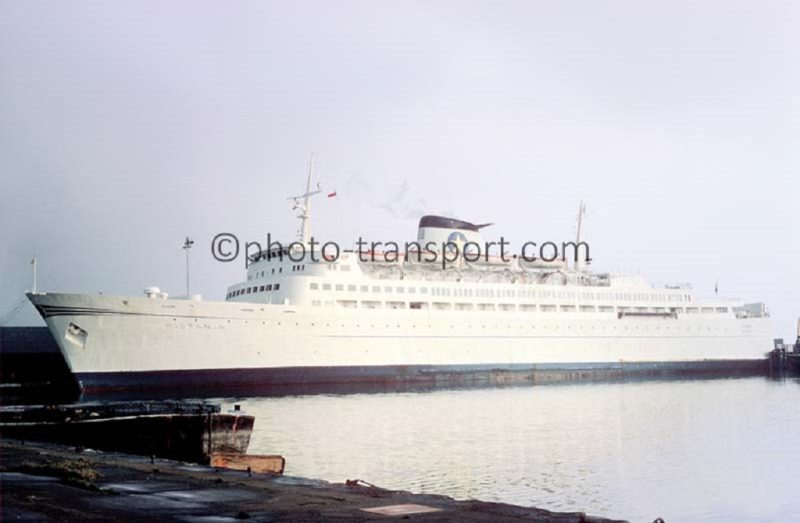
PATRICIA (4)
A new twin screw ferry was completed in March 1967 by the Lindholmen yard in Gothenburg harbour (Yard number 1095) for a new Swedish Lloyd Line service from Southampton to Bilbao, which lasted for ten years until August 1977 with good patronage during busy summer seasons, using Patricia (4) as well as Hispania (ex Svea) between 1969 and 1972. Patricia (4) was of 8,897 grt and 2,550 dwt with dimensions of overall length of 141.2 metres, moulded beam of 22.5 metres, moulded depth of 15.2 metres and a loaded draft of 5.9 metres. She had a service speed of 16 knots and a maximum speed of 18 knots, and was powered by four six cylinder four stroke Pielstick 6PC2-2L-400 diesel engines of 10,080 bhp, and was equipped with four 600 kilowatt generators and two forward thrusters. She had six passenger accessible decks with three decks having cabins with accommodation for 750 passengers on her overnight service, as well as 175 cars on her vehicle deck.
Patricia (4) was sold in 1978 to Stena Line and sent to Middle Docks at South Shields for rebuilding as a widened and deepened vessel with side sponson tanks for stability in the event of fire with water flooding her vehicle deck. She was cut in half horizontally and her vehicle deck was raised 1.2 metres to give more height to take taller vehicles. She now had a maximum passenger capacity of 1,200 and a minimum passenger capacity of 946, with 830 berthed passengers and 370 deck passengers for Stena Line shorter voyages. She was renamed Stena Oceanica of 12,764 grt and 2,068 dwt and was to remain with the Stena Group for almost twenty years under their many subsidiary companies. She became Stena Saga in 1979, Lion Queen in 1988 for Lion Ferry A/B on Baltic service, and then sailed through the Panama Canal to British Columbia to sail for Stena BC Line as Crown Princess Victoria in March 1990 with an onboard casino. Strong opposition was met from entrenched Native American onshore casinos as well as the State owned Alaskan Marine Highway ferries, and the service was quickly abandoned. In November 1990, she was chartered out as Crown Princess, as Pacific Star in December 1990, and as Sun Fiesta in June 1993, and then returned to the Baltic to sail again for Lion Ferry A/B in April 1994. She was sold by Stena Line in November 1997 to Far East interests for $5.7 million and renamed Putri Bintang for service as a casino ship at Kukup in Malaysia, and then in 1998 to New Century Cruise Line of Singapore and was renamed Amusement World to sail as a casino ship.
Amusement World sailed on overnight gaming cruises from Penang or Melaka, Johore and Singapore with a white funnel and a blue top and the logo of New Century Cruise Line on the white part. She had a blue and white hull with thin blue, yellow and red bands just below her weather deck. Long rows of gaming machines lined her Promenade Deck and ‘C’ deck and her other passenger decks, with her vehicle deck converted into an Egyptian themed casino called ‘The Pharaoh’s Chamber’. The huge number of gaming machines created extra heat, and thus it was necessary to install an extra ventilation plant on the aft deck.
Amusement World retained the 250 seat Patricia Restaurant offering western and oriental buffet style meals to all passengers, and A-la-carte service was also available. The Saloon Deck was refurbished with another smaller restaurant offering cooked speciality meals, as well as karaoke facilities and massage parlours. The Lion Bar hosted a daily show themed on magician acts and trivia games to keep the gambling tourists entertained, with all drinks flowing from the bar until after midnight. The Sports Bar was a jazz themed music lounge offering darts boards, a mini golf course, and ping pong tables.
Amusement World was initially registered at Funafuti in Tuvalu and then at Panama, she was last registered at Malakal Harbour, an anchorage at volcanic Koror Island in the Palau Islands to the west of Caroline Islands in the Pacific at position 7°20′ North, 134°27′ East. The Palau International Ship Registry was set up in 2012 and the first two ships were registered at an inauguration ceremony on 28th September 2012 as the casino cruise ships Amusement World and Leisure World, both owned by the Hong Kong China based New Century Cruise Line.
They were both sold for breaking up for around $3.5 million each to NKD Maritime Ltd. in India for the scrapping beaches at Alang in the Gulf of Khambhat, and both departed from Singapore anchorages in May 2021 with a call at Port Klang in the Straits of Malacca, with the former Patricia (4) beached on 2th August 2021 after a long career of 54 years. She had been well maintained during this long period of time, with a refit in 1988 at the Nobiskrug Werft A. G., and subsequent dry dockings in 1990, 1994 and 1997, and her last refit was in 2014.
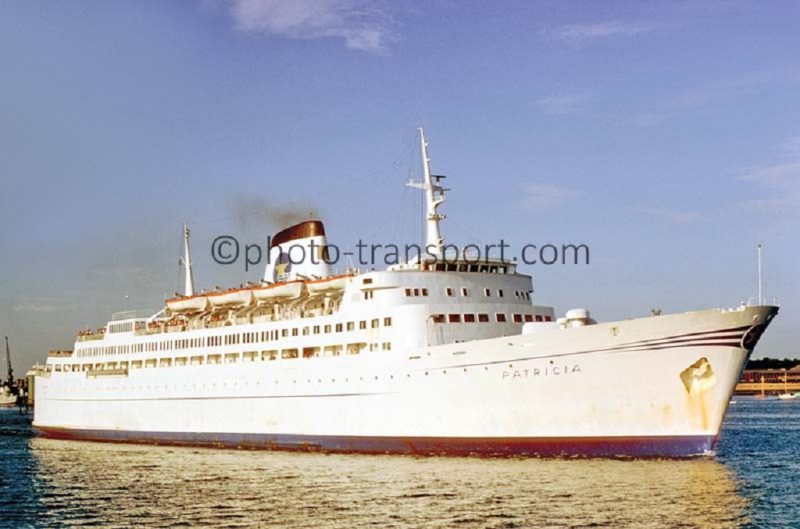
SWEDISH LLOYD LINE FINALE
The Lindholmen yard in Gothenburg and the Astilleros de Cadiz yard in Spain managed to complete seven units of the ‘Italia’ class of engines aft general cargo ships between 1961 and 1964 named Italia, Gallia, Dalmatia, Scania, Segovia, Hispania and Industria. They were given sufficient hull strength by the shipbuilders to operate as ‘open’ hatch ships, although equipped with sliding hatch covers, and were able to reduce the company Mediterranean fleet of thirty ships to only twenty ships.
The seven ships originally had five holds served by four electric cranes, but were lengthened in 1967 to six holds served by five electric cranes, increasing their deadweight from 4,600 dwt to 5,925 dwt.
The careers of this septet of ships was as follows:-
Italia built by Lindholmen in 1961, and sold to Egypt in 1974 and broken up in 2004
Gallia built by Lindholmen in 1961, sold to Finland in 1974, and broken up in 1988 in Bangladesh
Dalmatia built by Lindholmen and sold in January 1976 to Hong Kong owners and renamed Xin Du, later broken up
Scania built by Lindholmen in 1962 and sold in 1973 under the flag of Liberia and broken up in 1999 in India
Segovia built at Cadiz in 1963 and sold in 1971 to Svenska Orient Line (Brostrom) and broken up in 1987 at Kaohsiung
Hispania built in 1964 at Cadiz and renamed Valencia in 1968, was sold to Cypriot owners in 1977 and wrecked in 1988
Industria built in 1964 at Cadiz was sold to Cypriot owners in 1977 and wrecked in 1994
A new trade was entered in 1957 with the order for the wine tanker Vinia of 895 dwt and completed in 1959 by the Solvesborg yard. She had 34 glass enamelled tanks and was owned 75% by Swedish Lloyd Line and 25% by Svenska Orient Line (Brostrom) after receiving a long term contract to ship wine in bulk from Vin & Spritcentralen.
Two further wine tankers were ordered on the same ownership style and on contract to the same wine dealer from the Vaagen Verft yard in Norway and were completed as Vinlandia of 1,425 dwt in 1966 and Vindemia of 1,660 dwt in 1969.
All three wine tankers were transferred to the ownership of the Brostrom Group in 1977 on the takeover of Swedish Lloyd Line after 108 years of trading as an independent Swedish shipping company.
A minority shareholding had been obtained in 1917 when Dan Brostrom was appointed Chairman of Swedish Lloyd Line, and a majority holding was obtained by the Brostrom family in 1971.
Two ro-ro ships of 4,400 dwt had been completed in 1972/73 at Vigo in Spain as Fragaria and Stellaria, and were also taken over by the Brostrom Group in 1977/78. Five cargo ships had been chartered from Swedish and German owners in post-war years, and the passenger ferry Nils Holgersson of TT-Linie of 3,843 grt and built in 1962 was chartered in 1969 for a service from Marseille to Palma (Majorca) and Porte Torres (Sardinia) under the name of Sardaigne.
In 1966, the hovercraft company Hoverlloyd, jointly owned by Swedish Lloyd Line and Swedish Amerika Line, began its service between Pegwell Bay at Ramsgate and Calais.
This business was taken over in its entirety by the Brostrom Group in 1976, and six years later Hoverlloyd merged with the competing hovercraft company Seaspeed to form Hoverspeed, which continued to operate Cross Channel services until it was discontinued in Millennium year of 2000.

POSTSCRIPT
Ferry enthusiasts had been following the careers with much interest over decades of the beautiful Lindholmen built sisters Saga (3), Svea and Patricia (4), as well as the very similar handsome Spero of Ellerman Wilson Line from the Birkenhead yard of Cammell, Laird & Co. Ltd.
A normal ship’s lifetime career may well be only 20 to 25 years, but all four of the ferries featured in this article survived for almost doubled this figure, with Patricia (4) sailing for the very long period of 54 years. She was a favourite ship for many ship enthusiasts and her passing must be sad to say the least.
This quartet are a great testimony to the quality of work of the naval architects, interior designers and all of the personnel of the shipbuilders and suppliers.
The very good lines of their hulls and plenty of sheer at the bow are not often seen in the ferries of today.

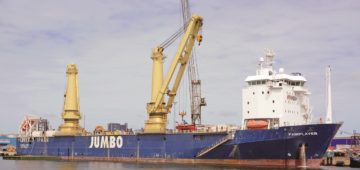



Comments
Sorry, comments are closed for this item